Sox2 is an androgen receptor-repressed gene that promotes castration-resistant prostate cancer
- PMID: 23326489
- PMCID: PMC3543364
- DOI: 10.1371/journal.pone.0053701
Sox2 is an androgen receptor-repressed gene that promotes castration-resistant prostate cancer
Abstract
Despite advances in detection and therapy, castration-resistant prostate cancer continues to be a major clinical problem. The aberrant activity of stem cell pathways, and their regulation by the Androgen Receptor (AR), has the potential to provide insight into novel mechanisms and pathways to prevent and treat advanced, castrate-resistant prostate cancers. To this end, we investigated the role of the embryonic stem cell regulator Sox2 [SRY (sex determining region Y)-box 2] in normal and malignant prostate epithelial cells. In the normal prostate, Sox2 is expressed in a portion of basal epithelial cells. Prostate tumors were either Sox2-positive or Sox2-negative, with the percentage of Sox2-positive tumors increasing with Gleason Score and metastases. In the castration-resistant prostate cancer cell line CWR-R1, endogenous expression of Sox2 was repressed by AR signaling, and AR chromatin-IP shows that AR binds the enhancer element within the Sox2 promoter. Likewise, in normal prostate epithelial cells and human embryonic stem cells, increased AR signaling also decreases Sox2 expression. Resistance to the anti-androgen MDV3100 results in a marked increase in Sox2 expression within three prostate cancer cell lines, and in the castration-sensitive LAPC-4 prostate cancer cell line ectopic expression of Sox2 was sufficient to promote castration-resistant tumor formation. Loss of Sox2 expression in the castration-resistant CWR-R1 prostate cancer cell line inhibited cell growth. Up-regulation of Sox2 was not associated with increased CD133 expression but was associated with increased FGF5 (Fibroblast Growth Factor 5) expression. These data propose a model of elevated Sox2 expression due to loss of AR-mediated repression during castration, and consequent castration-resistance via mechanisms not involving induction of canonical embryonic stem cell pathways.
Conflict of interest statement
Figures
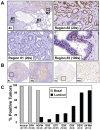
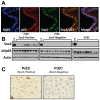
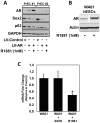

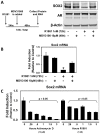
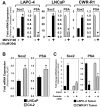



Similar articles
-
A novel antiandrogen, Compound 30, suppresses castration-resistant and MDV3100-resistant prostate cancer growth in vitro and in vivo.Mol Cancer Ther. 2013 May;12(5):567-76. doi: 10.1158/1535-7163.MCT-12-0798. Epub 2013 Mar 14. Mol Cancer Ther. 2013. PMID: 23493310
-
Methylselenol prodrug enhances MDV3100 efficacy for treatment of castration-resistant prostate cancer.Int J Cancer. 2013 Nov;133(9):2225-33. doi: 10.1002/ijc.28202. Epub 2013 May 9. Int J Cancer. 2013. PMID: 23575870 Free PMC article.
-
TACC2 is an androgen-responsive cell cycle regulator promoting androgen-mediated and castration-resistant growth of prostate cancer.Mol Endocrinol. 2012 May;26(5):748-61. doi: 10.1210/me.2011-1242. Epub 2012 Mar 28. Mol Endocrinol. 2012. PMID: 22456197 Free PMC article.
-
Oxidative stress and androgen receptor signaling in the development and progression of castration-resistant prostate cancer.Free Radic Biol Med. 2011 Oct 1;51(7):1320-8. doi: 10.1016/j.freeradbiomed.2011.07.011. Epub 2011 Jul 23. Free Radic Biol Med. 2011. PMID: 21820046 Review.
-
Androgen action in the prostate gland.Minerva Urol Nefrol. 2012 Mar;64(1):35-49. Minerva Urol Nefrol. 2012. PMID: 22402316 Review.
Cited by
-
Knocking down SOX2 overcomes the resistance of prostate cancer to castration via notch signaling.Mol Biol Rep. 2023 Nov;50(11):9007-9017. doi: 10.1007/s11033-023-08757-y. Epub 2023 Sep 16. Mol Biol Rep. 2023. PMID: 37716921
-
Tumor quiescence: elevating SOX2 in diverse tumor cell types downregulates a broad spectrum of the cell cycle machinery and inhibits tumor growth.BMC Cancer. 2020 Oct 1;20(1):941. doi: 10.1186/s12885-020-07370-7. BMC Cancer. 2020. PMID: 32998722 Free PMC article.
-
Elevating SOX2 Downregulates MYC through a SOX2:MYC Signaling Axis and Induces a Slowly Cycling Proliferative State in Human Tumor Cells.Cancers (Basel). 2022 Apr 12;14(8):1946. doi: 10.3390/cancers14081946. Cancers (Basel). 2022. PMID: 35454854 Free PMC article.
-
Development of Neuroendocrine Prostate Cancers by the Ser/Arg Repetitive Matrix 4-Mediated RNA Splicing Network.Front Oncol. 2018 Apr 3;8:93. doi: 10.3389/fonc.2018.00093. eCollection 2018. Front Oncol. 2018. PMID: 29666783 Free PMC article.
-
Widespread activation and critical role of EMT and stemness in the neuroendocrine differentiation of prostate cancer (Review).Oncol Rep. 2025 Sep;54(3):109. doi: 10.3892/or.2025.8942. Epub 2025 Jul 11. Oncol Rep. 2025. PMID: 40641143 Free PMC article. Review.
References
-
- Huggins C, Stevens RE, Hodges CV (1941) Studies on Prostate Cancer: II. The Effects of Castration on Advanced Carcinoma of the Prostate Gland. Archives of Surgery 43: 209–223.
-
- Isaacs JT, Isaacs WB (2004) Androgen receptor outwits prostate cancer drugs. Nat Med 10: 26–27. - PubMed
-
- Singh P, Uzgare A, Litvinov I, Denmeade SR, Isaacs JT (2006) Combinatorial androgen receptor targeted therapy for prostate cancer. Endocr Relat Cancer 13: 653–666. - PubMed
-
- Takahashi K, Yamanaka S (2006) Induction of pluripotent stem cells from mouse embryonic and adult fibroblast cultures by defined factors. Cell 126: 663–676. - PubMed
-
- Rodriguez-Pinilla SM, Sarrio D, Moreno-Bueno G, Rodriguez-Gil Y, Martinez MA, et al. (2007) Sox2: a possible driver of the basal-like phenotype in sporadic breast cancer. Mod Pathol 20: 474–481. - PubMed
Publication types
MeSH terms
Substances
Grants and funding
LinkOut - more resources
Full Text Sources
Other Literature Sources
Medical
Research Materials

